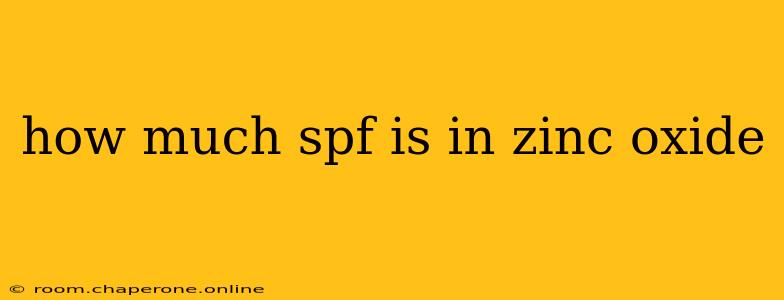How Much SPF is in Zinc Oxide? Understanding the Sun Protection Factor of Zinc Oxide
Zinc oxide is a popular and effective ingredient in sunscreens, renowned for its broad-spectrum protection against both UVA and UVB rays. But unlike chemical sunscreens which have a specific SPF number assigned based on laboratory testing, zinc oxide's SPF isn't a simple, single number. The SPF of a sunscreen containing zinc oxide depends on several crucial factors. Let's delve into the details.
The Complexity of Zinc Oxide SPF
Unlike chemical UV filters, zinc oxide's sun protection isn't defined by a single SPF value. Instead, its effectiveness depends on:
-
Concentration: The higher the concentration of zinc oxide in the sunscreen formulation, the higher the SPF. A sunscreen with a 25% concentration of zinc oxide will generally offer a higher SPF than one with a 10% concentration. Formulations commonly range from 5% to 25% or even higher.
-
Particle Size: The size of the zinc oxide particles plays a significant role. Smaller particles provide better spreadability and a less noticeable white cast, but their effectiveness can vary. Nano-sized zinc oxide particles are more effective at absorbing UV rays than larger particles but have generated some controversy regarding their potential safety. Many manufacturers now opt for micronized zinc oxide, striking a balance between effectiveness and safety concerns.
-
Formulation: Other ingredients in the sunscreen, like other UV filters or emulsifiers, can affect the overall SPF and the way the zinc oxide interacts with the skin. The final formulation process significantly impacts the final SPF rating.
-
Application Method: The amount of sunscreen applied is crucial. Laboratory tests often use a far greater amount of sunscreen than is typically applied in real-world scenarios. A thin layer will offer less protection than a more generous application.
Determining the SPF of a Zinc Oxide Sunscreen
The only reliable way to know the SPF of a sunscreen containing zinc oxide is to look at the SPF rating clearly stated on the product label. Manufacturers are legally required to test their sunscreens and display the SPF value obtained through standardized testing. This number reflects the complete formulation's effectiveness, not just the zinc oxide content.
Don't try to estimate the SPF based solely on the zinc oxide concentration. It's a complex interplay of factors, and the manufacturer's testing ensures accurate and reliable sun protection information.
Zinc Oxide: A Broad-Spectrum Protector
Regardless of the exact SPF value, zinc oxide offers significant advantages:
- Broad-spectrum protection: It effectively blocks both UVA and UVB rays, crucial for preventing sunburn, premature aging, and skin cancer.
- Gentle on sensitive skin: It's often considered gentler than chemical sunscreens and suitable for those with sensitive skin or allergies.
- Physical barrier: It works by creating a physical barrier on the skin, reflecting UV rays away.
Conclusion: Focus on the Label SPF
In short, there's no single answer to "how much SPF is in zinc oxide." The SPF is a result of the entire sunscreen formulation, and the concentration and particle size of the zinc oxide are just contributing factors. Always rely on the SPF number clearly stated on the sunscreen label to understand the level of sun protection provided. Choosing a broad-spectrum sunscreen with an appropriate SPF for your skin type and activity level is essential for effective sun protection.

